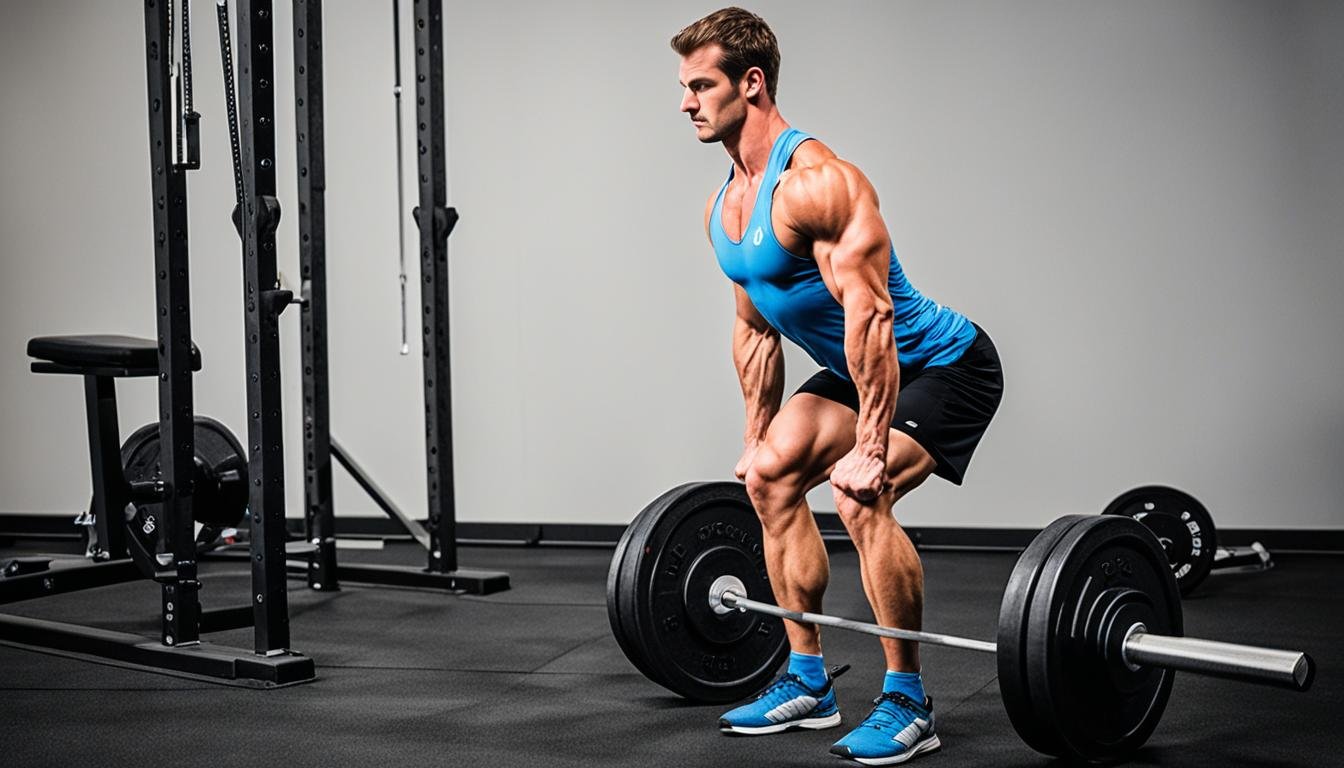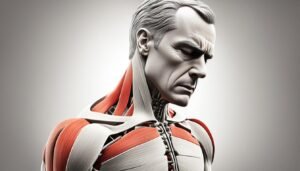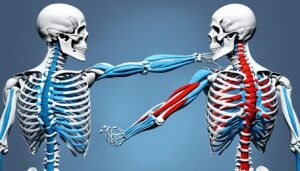The deadlift is a key exercise that works your glutes, quads, and core. It’s great for getting stronger. Yet, if you do it wrong, you might get lower back pain. This happens because the move puts a lot of pressure on the lower back, where your ribs meet the hips. It’s important to know the signs. You need to tell apart normal muscle soreness from pain that could mean an injury.
After doing deadlifts, you might feel stiff and sore in your leg and butt muscles. This is called delayed-onset muscle soreness (DOMS). It’s normal and means your muscles are getting stronger. But, if you feel a sharp, burning pain or if you have trouble walking or balancing, you should see a doctor. They will check if it’s something more serious. Like if the pain goes down your legs or you feel weak, numb, or tingly, those are serious signs too.
Key Takeaways
- Doing the deadlift with the right technique is key to avoiding lower back pain.
- It’s okay to feel sore after deadlifts, but sharp, strong pain needs attention.
- To prevent pain, warm up with moving exercises and keep your core and hamstrings strong and flexible.
- If you hurt your lower back, using ice, heat, and light stretches can help you heal.
- If your back pain doesn’t go away, talking to a doctor is a good idea.
Understanding Lower Back Pain After Deadlifts
After you do deadlifts, feeling sore is normal. It happens because your muscles get used to the hard workout. Around 70% of people feel this muscle soreness after deadlifts. They don’t usually feel serious pain.
Differentiating Pain from Muscle Soreness
It’s key to tell apart usual soreness from real pain that signals an injury. Deadlifts stress the lower back a lot. This can make your quads, hamstrings, and glutes ache. If you hurt while lifting, stop and see a doctor if it keeps hurting.
Red Flags and Signs of Injury
Sharp or burning pain after deadlifting means you might be hurt. If you can’t walk well or feel pain in your legs, see a doctor. Symptoms like weakness, numbness, or tingling need attention too.
To avoid back pain from deadlifts, warm up correctly and use the right form. Fix any issues and follow good tips to lower the risk of getting hurt. This way, you can work out safely and well.
Proper Deadlift Form and Technique
Learing good deadlift form and deadlift technique stops lower back pain. It also makes the exercise work better for you. You need to pay close attention to the deadlift setup, deadlift pull, and deadlift lockout steps.
The Setup Phase
Start by standing with your feet a shoulder’s width apart. The bar should be right over the center of your feet. Bend your knees a bit and balance your weight well.
Then, at the hips, keep your back straight, chest high, and core tight. Grab the bar with one hand up and one hand down.
The Pull Phase
For the deadlift pull part, lift by pushing your heels down. Stand up straight by straightening your legs and popping your hips forward. Always keep your back straight and your shoulder blades directly over the bar.
The Lockout Phase
At the top of the lift, clench your rear-end muscles tight. This helps keep your lower back happy. Then lower the weight slowly back to the ground.
By doing each step of the deadlift right, you get more from the move. You also lower the chance of hurting your back. Win, win!
lower back pain after deadlift
Common Causes of Lower Back Pain from Deadlifts
Some movements when doing deadlifts can up the chances of hurting your lower back. These movements include rounding, twisting, and arcing your spine. If you lift weights that are too heavy, you can hurt your back more.
Improper Form and Body Mechanics
Getting the form and mechanics right is key to avoid hurting your lower back after deadlifts. Keep your back straight and your chest up. Make sure to tighten your core. Doing deadlifts the wrong way makes other muscles try to help too much. This can leave you with a sore back.
It’s very important to keep good posture and use the right technique while deadlifting. This way, you stop putting too much pressure on your lower back. Focus on how you move to lower the chance of hurting your back.
Treatment Options for Lower Back Pain
Feeling lower back pain after lifting weights? You have choices for help. Take pain relievers like ibuprofen to lower pain and swelling. Ice and heat can also ease your discomfort.
Nonsteroidal Anti-inflammatory Drugs (NSAIDs)
NSAID pills such as ibuprofen (like Advil, Motrin) or naproxen (like Aleve) can lessen your hurt. They stop the making of chemicals that lead to soreness and swelling.
Ice and Heat Therapy
To reduce pain, ice your back for 15-20 minutes regularly. Ice makes your blood vessels small, which lowers swelling. For muscle relief, use a hot pack to boost blood flow.
Staying Active and Stretching
Resting is key, but moving gently daily also helps. Do stretches for your back, core, and hips. This can speed up healing and stop more pain.
Attending to the pain helps avoid further issues. Or it’s getting worse, see a specialist. They will set you up with the right plan to recover fully.
Deadlift Variations for Lower Back Health
The standard deadlift builds strength well. But, the Romanian deadlift does too and helps your lower back health. It’s a bit different because you start with the weights in your hands. It might be better for people not very flexible in their hamstrings.
The Romanian deadlift is good for moving your hips right. It makes your lower back and legs stronger. This makes your back more stable and mobile. Since the weights stay close to your body, it might feel better for your back than the usual deadlift.
Adding the Romanian deadlift to your workouts can boost your strength safely. It lowers the chance of hurting your back if you lift wrong or too heavy. Just remember to do it right and pay attention to how your body feels. This is key to using different deadlift variations for a healthy lower back.
Preventive Exercises for Lower Back Pain
Doing certain exercises can make your core, glutes, and back muscles stronger. This is great for avoiding back pain when you lift heavy things. These exercises help keep your spine steady, activate your glutes, and make your core and back stronger and more flexible.
Wall Roll Exercise
The wall roll exercise is good for the lower back, hips, and glutes. Stand against a wall with your back, your feet 6 inches away. Roll down the wall slowly, one part of your back at a time, until your hips and knees are at 90 degrees. Then, roll back up. This move makes the lower back more mobile and stable.
Clamshell Exercise
The clamshell focuses on the glutes while steady your core and hips. Lie on your side with your knees bent and your feet together. Lift your top knee up while keeping your hips together. Then, lower it back down. Do the same on the other side to work both sets of your glutes.
Side Bridge Exercise
The side bridge workout makes your obliques strong and keeps your spine straight. Lie on your side with your elbow under your shoulder. Raise your hips up, with your weight on your forearm and feet. Hold for 30-60 seconds, and then change sides.
Bird Dog Exercise
The bird dog makes your core more steady and improves your balance. Get on your hands and knees. Stretch out your opposite arm and leg. Hold for some seconds, then change sides. Keep your core tight and your back straight while you do this.
Glute Bridge Exercise
The glute bridge focuses on your glutes and hamstrings. Lie on your back with your knees bent and feet flat on the floor. Squeeze your glutes to raise your hips, making a straight line from your knees to your shoulders. Hold for a bit, then lower down.
Doing these exercises often can make your core, glutes, and back very strong and steady. This will help lower your risk of getting hurt while you’re lifting heavy weights.
Deadlift Back Pain Prevention Strategies
Learning about the causes of lower back pain is key. Most injuries from deadlifting are due to muscle strains or ligament sprains. It’s vital to take time to heal correctly; otherwise, you might hurt yourself more.
Understanding Strains and Sprains
Expect intense pain for the first 48-72 hours. Using ice and heat, and avoiding heavy lifting can be helpful. Listen to your body during this time. Rest is crucial for getting better.
Proper Healing and Recovery
After your injury has healed, slowly return to deadlifts. Focus on doing them with the right form. Start with lighter weights. Then, you can increase the load as you feel ready.
Returning to Deadlifts After Injury
Know what strains and sprains are. Use smart recovery plans. Add deadlifts back to your workout slowly. This way, you can avoid back pain and keep up with your fitness goals.
Importance of Warm-up and Stretching
Getting ready for deadlifts is crucial for staying safe and avoiding back pain. Dynamic warm-ups do this job well. They get your muscles ready for deadlifts by working your glutes and core.
After deadlifts, spend time stretching your hips and hamstrings. This helps you recover better and improves how you move. Doing this will lower your risk for back pain and keep you safe from injuries during your deadlifts.
Don’t forget, a good deadlift warm-up and deadlift stretching are key. These steps are important for injury prevention. Taking care of yourself this way improves your strength and keeps your lower back healthy.




